

Facilitating trade and investment is a major task in building the Belt and Road.
China has signed bilateral investment agreements with 135 countries and regions.
The World Bank has estimated that by 2030, BRI-related investments could lift 7.6 million out of extreme poverty and 32 million out of moderate poverty.
Wang Huiyao, CCG president, said the Belt and Road Initiative has gradually shaped new form and momentum of inclusive globalization that China is promoting, and the future decade is full of new opportunities and new hopes for a better world to come.

Tony Verb, co-founder of Singapore-based Zero Carbon Asia, emphasizes the pivotal role of China in global decarbonization efforts. He said decarbonization is across all industries and energy efficiency is very important and to create clean energy solutions is even more important and China has been leading that way for a while. He also noted that with more trust developed, there will be more activity in the context of decarbonization and cross-border investment and technology transfer opportunities.
Vanessa Xu, co-founder of Super Bridge Council, said that Chinese companies have, over the last 30 years, built and developed global capabilities not only in digital infrastructure but also in industrial and consumer applications atop that infrastructure. There are huge opportunities in these Belt and Road countries for Chinese companies to offer technology, education services, and technology transfer.
Lionel Zinsou, former prime minister of Benin, observed that Chinese companies are investing in manufacturing locally and domestically in his country with job creation. It creates motivation for investors worldwide looking at what China is achieving in Africa and reconsidering African investment as a profitable, sustainable investment.
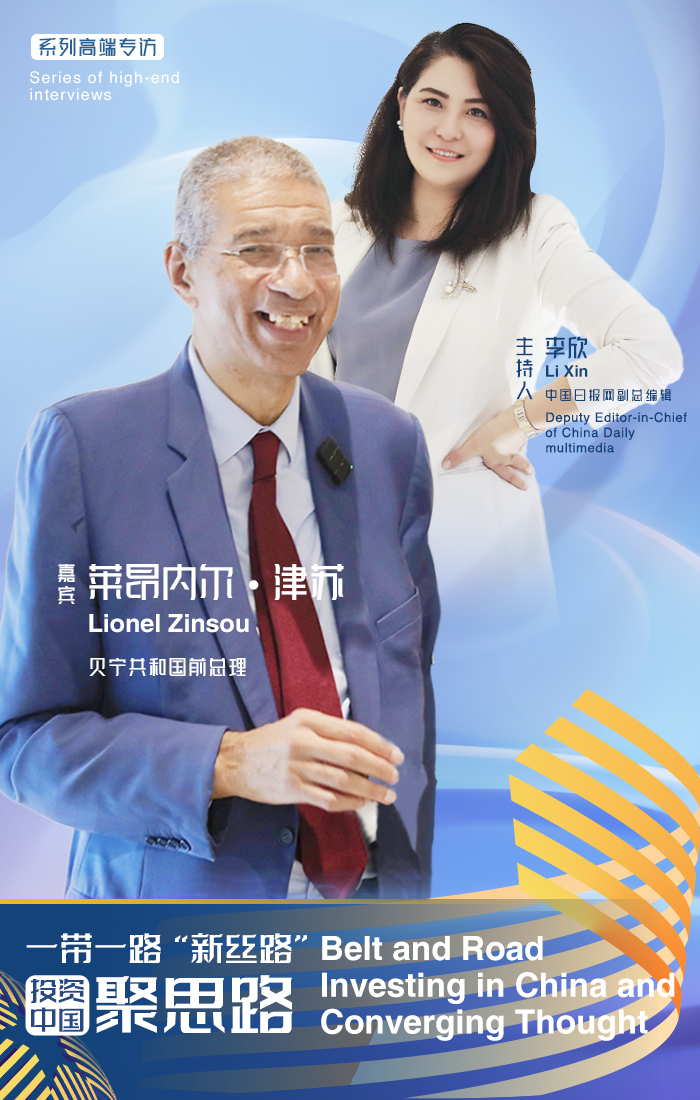
Umar Saif, federal minister for science and technology and minister of IT & telecommunication of Pakistan, said the Belt and Road Initiative is a transformative initiative to connect many countries in the world.
Sahar Nasr, economist and former Egyptian minister of investment and international cooperation, said prosperous growth can't be achieved without connectivity, among which trade and finance connectivity is critical. Therefore, the Belt and Road Initiative is key as it enhances connectivity with different infrastructure projects, allowing for more investments to come into countries involved in the initiative.
In the past decade, China has been at the forefront of collaborative efforts with nations worldwide, driving technological innovation and shaping the digital economy. Join China Daily website for exclusive interviews with business leaders and scholars sharing insights on investing in China's digital future.
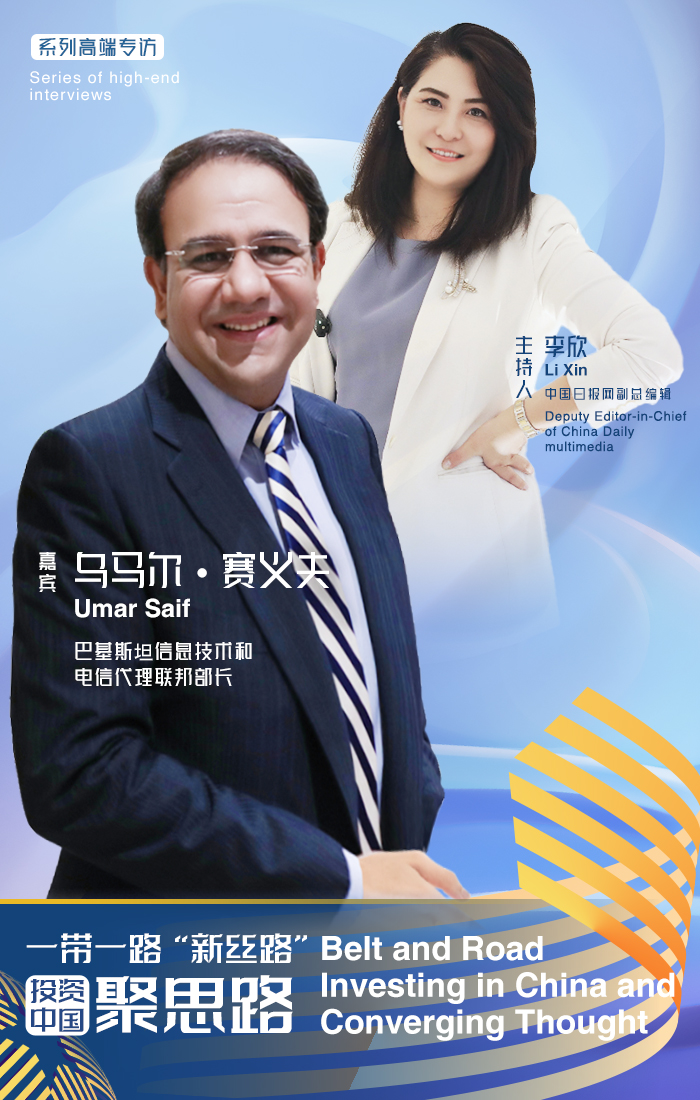
In the future, the digital roads constructed under the framework of the Belt and Road Initiative will embrace the same huge development potential as those of physically constructed roads, said Umar Saif, federal minister for science and technology and minister of IT & telecommunication of Pakistan, in an interview at "The Belt and Road: Investing in China and Converging Thought" event.
Looking back on the past decade, Saif said that the Belt and Road Initiative connects many countries along trade routes, with some becoming production countries, some becoming consumer countries, and some benefiting from China's strategic investments along the trade routes. He expressed his hope for Pakistan to become an integral part of the initiative in the future, and to have mutually beneficial relations with China.
With the continuous development of digitalization, Saif believes that the Belt and Road Initiative will also become a digital interconnection road. Pakistan is strategically close to China, with its ports and submarine internet cables. This digital linkage allows Pakistan to connect with Central Asian countries, China, and many other neighboring countries.
Saif said, "My favorite project is the fiber optic investment project from Kashgar, Xinjiang, China to Islamabad, Pakistan. This connection ultimately provides a digital link for other regions of the world. It is a ground route, but also a crystal route. Therefore, Pakistan can truly become an alternative transit route for internet traffic through the fiber optic investment project. Its endpoint is close to Pakistan, extending all the way to China and connecting the entire Central Asian countries."
When discussing the potential for future cooperation between Pakistan and China, Saif pointed out that Pakistan is a young country with 65 percent of its population under the age of 35. It is the world's seventh-largest mobile phone user country but has few mobile phone manufacturing companies. As an agricultural country, Pakistan does not have any agricultural technology startups with a market value of over $1 billion, while China has multiple agricultural technology startups worth tens of billions of USD. Therefore, the tremendous opportunities are not only for countries to invest in Pakistan's technology but also for Pakistan to acquire information, technology, and tools.
"Pakistan is a country with the potential for regional digital connectivity and has tremendous potential for cooperation with China in terms of economy, trade, high-tech product, and goods," Saif said.
"The Belt and Road: Investing in China and Converging Thought" themed event was organized by China Daily website and sponsored by China Internet Development Foundation.

China is playing a significant leading role in the global decarbonization campaign in which the Belt and Road Initiative will provide technical implementation solutions, said Tony Verb, co-founder of Singapore-based Zero Carbon Asia, in an interview at "The Belt and Road: Investing in China and Converging Thought" event.
Verb said that China's efforts in global decarbonization are crucial. Anyone concerned about green technology, green solutions, and the development of green economic transformation will be interested in China's carbon neutrality goals, which serve as a starting point for other countries in the region, Asian countries, and many developing countries to follow. It is not feasible to achieve industrial decarbonization and Asian decarbonization without China's leadership. When discussing decarbonization, energy efficiency is very important, and creating clean energy solutions is even more important. China's leadership in this regard has led them to decide to produce a large number of solar panels in China, and they are very positive about China continuing down this path.
"To be frank, I have been living in China for more than ten years. The development of Shenzhen is incredible. When I saw that the electrification rate of taxis and buses in Shenzhen reached 100 percent, I was enlightened, because I realized that no city in the world has a fully electrified public transportation system. Shenzhen, a city that was unknown twenty or thirty years ago, has now become a global leader in decarbonizing public transportation, which is truly inspiring. Whenever people around the world ask me for an important example of decarbonization, I always tell them this example, which inspires me and still inspires others," Verb said.
Verb said that the Belt and Road Initiative enables China to establish more trust with countries along the Belt and Road and other countries around the world, which is why there are now more opportunities for decarbonization, cross-border investment, and technology transfer. China has become one of the largest markets in the world, and many people are willing to cooperate with China in decarbonization and energy efficiency. This is not only an opportunity for China, but also a huge opportunity for the whole world.
Verb emphasized that the Belt and Road Initiative is very important for many countries along the Belt and Road. For many developing countries, their largest trading and industrial partners in the past, present, and possibly in the future are China. In terms of decarbonization, China may provide them with the new technological solutions or best practices they need. China not only has relevant policies but also a practical framework, which Verb believes is crucial for the market. For the world, the initiative is proposed under the background of green and decarbonization, which is crucial. It is positive for individuals, for China, and for the world.
"The Belt and Road: Investing in China and Converging Thought" themed event was organized by China Daily website and sponsored by China Internet Development Foundation.

China and Egypt have established favorable investment relationship under the framework of the Belt and Road Initiative, and the future cooperation embraces enormous potential, said Sahar Nasr, economist and former Egyptian minister of investment and international cooperation, in an interview at "The Belt and Road: Investing in China and Converging Thought" event.
Nasr said connectivity and trade links, as well as financial connections are crucial. All countries, including Egypt, China, and the African continent, hope for economic prosperity and growth, which cannot be achieved without connectivity. Therefore, the initiative is crucial because it strengthens connectivity through various infrastructure projects, allowing for more investment in Egypt, China, and neighboring countries, and creating job opportunities for Egypt's young, talented, and growing population. The initiative is an excellent opportunity to attract foreign direct investment from different regions.
Nasr said in the past few years, Egypt and China have developed a good partnership, focusing on cooperation in key areas that can enhance and promote mutual prosperity, such as transportation, energy, and education. In the transportation sector, the two countries have focused on constructing many infrastructure projects, facilitating the flow of both people and goods and services. Wind and solar power projects have created opportunities for mutual investment and attracting other investments. In the education sector, investing in human capital during the construction process is essential. As Rania El-Mashat, the Egyptian minister of international cooperation, said without human capital, infrastructure projects lead to nowhere. This is another important area for building investment-related development capacity and establishing a good cooperative relationship between the two countries.
Nasr emphasized that small and medium-sized enterprises (SMEs) play a significant role in both China and Egypt, as well as in most African countries and emerging economies. SMEs create employment opportunities and serve as engines for growth. Both governments and chambers of commerce attach great importance to this. Nasr considers herself fortunate to share the business opportunities in Egypt with the Egypt-China Chamber of Commerce, as SMEs have enormous potential and bring many opportunities to Egypt. Accessing funds has always been a challenge for SMEs. In this regard, Egyptian banks and China's development funds have provided great assistance. China also provides financial support for SMEs to conduct business and invest in Egypt through various forums and platforms.
Regarding investment, Nasr said Egypt offers a favorable investment environment and opportunities for investors. Egypt is eager to cooperate with Chinese investors. Its advantageous geographical location connects Asia and Africa. In addition, China and Asia can take advantage of the free trade agreement between Egypt and Africa to expand the market. Egypt is a young market, providing an opportunity to attract investment with low-cost labor, while the free trade agreement facilitates the smooth process of doing business in the region. Additionally, the region has untapped potentials and rich and diverse natural resources, such as the textile industry, renewable energy, and the digital industry. The operating rules of these industries have not been fully utilized. The Egypt-China partnership exists at the highest political level, with commitments made by leaders from both countries. The strong support from the government level instills confidence in investors from both sides. Egypt, especially the Suez Canal, is strategically located for the Belt and Road Initiative.
"We have known the famous historical Silk Road since we were young. The Belt and Road Initiative continues the significance of the Silk Road and has received support from many countries and sectors. This has been emphasized in many international forums that I have attended," said Nasr.
"The Belt and Road: Investing in China and Converging Thought "themed event was organized by China Daily website and sponsored by China Internet Development Foundation.
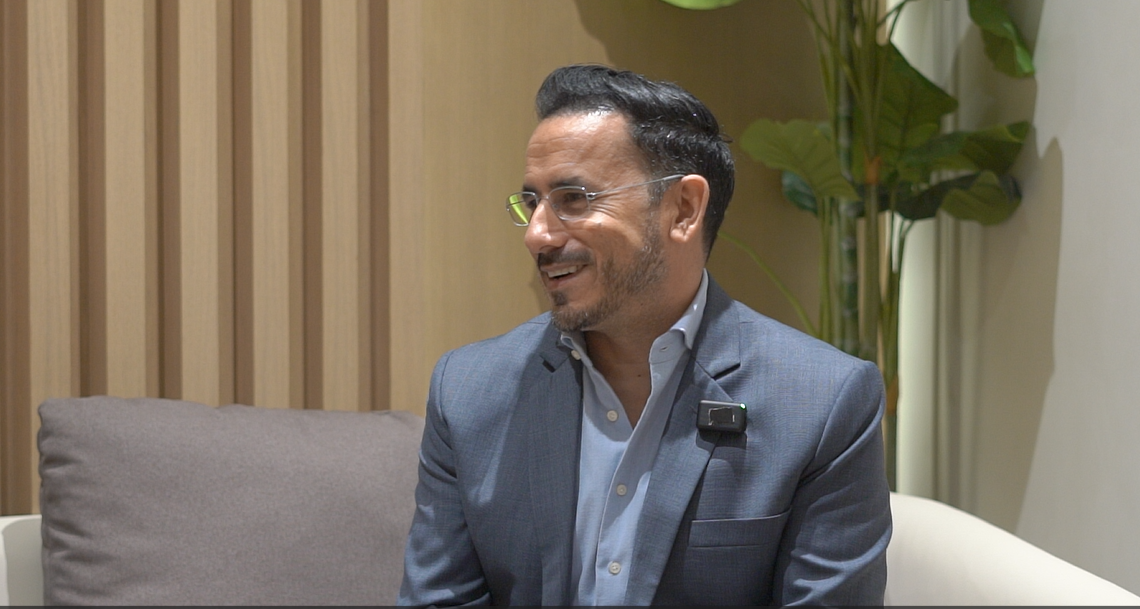
Sharif El-Badawi, CEO of Dubai Future District Fund, expressed his hope to carry out more communication and cooperation with China's scientific and technological elites to jointly achieve fruitful results.
El-Badawi said in an interview at "The Belt and Road: Investing in China and Converging Thought" themed event that there is great potential for cooperation and future development between Dubai Future District Fund and Chinese tech companies and investors. He admires the practices of his Chinese counterparts, stating that China has truly driven the development of disruptive technologies over the past 20 years, which are highly scalable.
Besides, there are many Chinese companies in the UAE that are constructing advanced energy plants, other types of infrastructure, and various industrial fields. Therefore, El-Badawi hopes to see more startups come and learn from China's operational methods. He said the future prospects for cooperation are very promising and they are eager to see cross-border talent exchanges between different regions.
El-Badawi emphasized the crucial importance of the Belt and Road Initiative for the future of the world. Cooperation between countries is necessary, as no single country can solve or respond to future challenges alone. Therefore, a solid foundation for cooperation is essential, and the initiative provides such a foundation by opening up markets between different countries.
He said the fund has over 60 government entity projects ranging from pharmaceuticals, logistics, real estate, tourism, and aviation to ports in Dubai. Therefore, within these projects in Dubai, Chinese tech companies are likely to find suitable partners for cooperation. El-Badawi hopes to introduce more research and development capabilities to create more profound levels of technology, and he is excited about the prospects of future cooperation with Chinese technology.
"We have come across many interesting technologies, but more importantly, I think there are like-minded partners from different regions of the world who have started to communicate and engage in dialogue. I believe this is the beginning of harvesting fruitful results in the future," said El-Badawi.
"The Belt and Road: Investing in China and Converging Thought" themed event was organized by China Daily website and sponsored by China Internet Development Foundation.

China is navigating the global market to realize the sustainable development and transformation with its cutting-edge technologies, said Michael Sheren, former Bank of England senior advisor and G20 chairman, in an interview at "The Belt and Road: Investing in China and Converging Thought" themed event.
Sheren said it is crucial to push everything onto the global stage and achieve sustainable development. One advantage that China and some other countries have is technology. One of the biggest global trends is progressing toward sustainable development, which is impossible without technology. China is a global leader and pioneer in the electric vehicle and wind energy fields, which are global in nature. China should be a true market leader, with supply chains that serve not only the surrounding regions but also the world. These important elements of transformation will be part of the global transformation solution.
When discussing China's achievements in environmental crisis management and sustainable development, Sheren said China is the first country in the world to propose "waste sorting". China is currently discussing coordinating waste sorting policies with the European Union. Therefore, how to make sustainable development effective is an important and indispensable factor.
Sheren said the International Monetary Fund has done outstanding work by considering carbon taxation as a transformation method. There are reports that development banks, the Asian Development Bank, the Asian Infrastructure Investment Bank, and other institutions will join forces to collaborate. Therefore, not only development banks in Asia but also those in Europe, South America, and Africa will cooperate. This level of cooperation is very positive. Hence, more collaboration like this can be expected in the future. The G20 is cooperating, development banks are cooperating; this is a good sign.
According to Sheren, the Chinese market undoubtedly offers great opportunities for foreign investment. China has skilled talent, great technology, and outstanding research. He believes that as long as it is open, there will be tremendous opportunities.
"It is well known that the People's Bank of China has the first digital currency, which could be very attractive for cross-border trade. As a senior advisor at the Bank of England, I appeared alongside Dr Yi Gang, who was the vice-governor at the time, in the hall of the London Stock Exchange. At that time, China issued RMB and other denominations, green asset-backed securities, because London is an offshore RMB trading center, as well as Frankfurt and Singapore. So, imagine if you are a potential Chinese investor and you see the funding mobility of the digital RMB being able to move to Singapore, to Frankfurt, and to London. I think it's an interesting field, it could be exciting in the future," Sheren said.
"The Belt and Road: Investing in China and Converging Thought" themed event was organized by China Daily website and sponsored by China Internet Development Foundation.

The Belt and Road Initiative promotes multi-dimensional cooperation and facilitates connectivity among countries involved in the initiative, said Xu Ying, co-founder of Super Bridge Council, at "The Belt and Road: Investing in China and Converging Thought" themed event .
Xu said this year marks the first decade of the initiative. During this period, the initiative has promoted the understanding of financial infrastructure, technology, education, cultural cooperation, and comprehensive collaboration among the countries. Countries have come to realize that despite facing various challenges, the world is interdependent. Without cooperation with others, each country will be unable to achieve a bright future on its own.
Xu said the cooperation between the countries can span a wide range of areas. First, affordable, accessible, and applicable technologies can be introduced. They can be customized based on local conditions. Second, talent and education can be introduced, enabling local residents to not only become industrial workers but also acquire the ability for continuous learning, thereby earning longer-term income in the labor market. Last, global capital can be brought in, which often comes with an innovative mindset, visionary ideas, and forward thinking. This is particularly important for developing countries, as they need a global perspective, placing themselves on the global stage and considering their development under global conditions. This type of development is more sustainable. Moreover, many developing countries involved in the initiative, due to their traditionally lagging tangible infrastructure, are eager to introduce digital infrastructure to address the related weaknesses linked to material infrastructure.
Xu said in Nigeria there is a strong desire to develop remote digital healthcare solutions to provide medical services to far-flung areas that lack roads, ports, and airports. Therefore, digitalization has actually become a major development focus for all countries involved in the initiative.
Xu said Chinese enterprises have not only established and developed global capabilities in digital infrastructure over the past 30 years but also built and deployed industrial and consumer application capabilities on top of the infrastructure. In these Belt and Road countries, Chinese enterprises have significant opportunities to provide them with technology, education, services, and technology transfers, enabling these countries to establish economic connections between individuals and achieve micro-level connectivity.
Regarding the future development of the initiative, Xu summarized it with two keywords. The first is "globalization," which means the combination of globalization and localization. For Chinese enterprises to achieve globalization through the markets of countries involved in the initiative, they need to maintain a global perspective and have a mindset that truly integrates and understands local cultures, respects and fully accepts local cultures, and truly establishes long-term sustainable structures there. The second keyword is "long-term perspective."
Many countries involved in the initiative are lagging behind developed countries or even China by several years or even decades. However, most of these countries actually have a very young population who are either digitalizing or being digitalized, and they aspire to a better life. Xu said these are fundamental factors driving social development, but they require time. Therefore, it is important for enterprises aiming at globalization through these markets to not be driven by short-term gains or speculation but rather to truly delve into a long-term opportunity, which will ultimately yield fruitful and highly valuable results.
"The Belt and Road: Investing in China and Converging Thought" themed event was organized by China Daily website and sponsored by China Internet Development Foundation.
KUALA LUMPUR -- The China-proposed Belt and Road Initiative (BRI) offers hope of a renewed economic recovery despite global uncertainties, a Malaysian observer has said.
This is being achieved while giving participating countries full autonomy to act, in contrast with Western-led projects that force countries into bloc confrontation, Lee Pei May, a political expert at the International Islamic University Malaysia, told Xinhua in a recent interview.
"BRI participating countries have full agency to decide what kind of projects they wish to undertake that would bring the most benefit to their citizens ... and they (China) do not dictate terms to BRI partners," she said.
Contrary to the inclusive nature of the BRI, Lee said the United States, in particular, has a history of using economic assistance as leverage over other countries.
The expert said such approach directly led to global division, ultimately leading to bloc confrontation during the Cold War. The United States has continued this approach to the present day, using economic coercion and sanctions as warfare.
Instead of dividing nations, Lee said, the BRI has been critical in helping connect countries, particularly developing ones, by building up their infrastructure in ways they would not be able to on their own.
"The BRI has provided massive assistance, mainly to developing countries, for infrastructure development, which ... has been denied to them for many decades due to insufficient capital," she said.
Speaking of the successful ongoing construction of the East Coast Rail Link, Malaysia's mega rail project being built by China Communications Construction Company, Lee called it a shining example of the spirit of the BRI.
The project will bring substantial economic benefits to the country by helping the rural east coast increase connectivity and providing jobs, she said.
Lee said that the BRI will continue to counter global instability and uncertainty by building genuine connections through infrastructure and people-to-people connections.
"By emphasizing cultural exchanges and people-to-people interactions, the BRI helps with economic diversification, as the recipient countries are able to decide on their development path," she said. "What the BRI offers the world is the testament that prosperity could be achieved by various countries with even their varying national conditions."
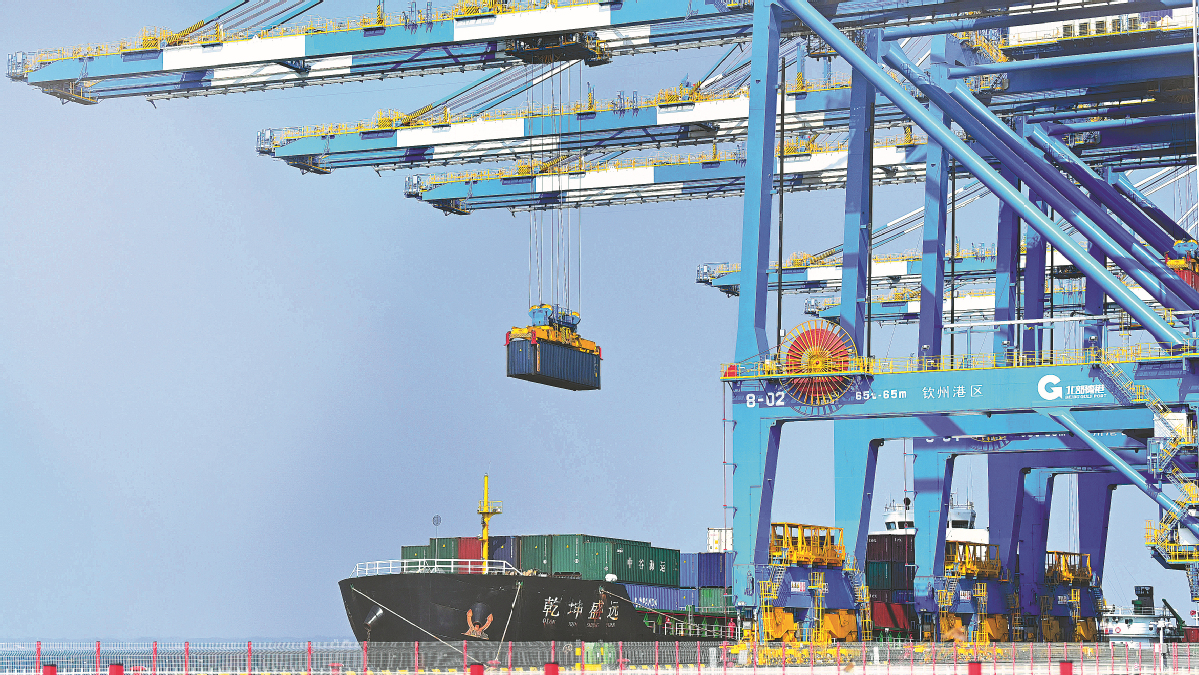
China will further advance the construction of high-quality overseas projects and expand the network of free trade zones, as part of its efforts to increase the scale and enhance the quality of economic cooperation with countries involved in the Belt and Road Initiative, a senior official said on Wednesday.
Following the approach of consultation and collaboration for shared benefits, China's practical cooperation in economy and trade with Belt and Road countries has grown in scope and quality over the past decade and achieved win-win results, said Guo Tingting, vice-minister of commerce.
"China's supersized market has provided important development opportunities for countries involved in the BRI, and goods originating in these countries now account for nearly half of China's total imports," Guo said in an interview with Xinhua News Agency, emphasizing that more than 110 Belt and Road countries count China as an important trade partner.
Data from the General Administration of Customs showed that China's imports and exports with Belt and Road countries increased from 6.46 trillion yuan ($885 billion) in 2013 to 13.76 trillion yuan last year.
Meanwhile, two-way investment between China and other countries involved in the BRI totaled more than $380 billion between 2013 and 2022, of which China's outward direct investment exceeded $240 billion, according to a white paper released by the State Council Information Office on Tuesday.
Guo said that China's trade and investment cooperation with Belt and Road countries has aided in the efficient allocation of resources, accelerated the integrated development of the industrial and supply chains, and injected more vitality into the creation of an open global economy.
According to a World Bank report, the BRI increased the trade of participating parties by 4.1 percent and attracted 5 percent more foreign investment. By 2030, the BRI will generate $1.6 trillion in global revenue each year, accounting for 1.3 percent of global GDP.
Going forward, China will better align with the policies, planning and industries of countries participating in the BRI, in order to further enhance infrastructure connectivity, the vice-minister of commerce said, underlining that infrastructure construction is an important area of the initiative.
In the past 10 years, China has signed contracts worth $2 trillion with Belt and Road countries and completed projects worth $1.3 trillion, covering a wide range of sectors including transportation, electricity, petrochemical, communication, water conservancy and wastewater treatment, Guo said.
"Belt and Road countries have benefited from these cooperation projects in terms of improving infrastructure development, promoting connectivity, enhancing people's well-being and strengthening their ability to develop," she said.
In the first eight months of this year, Chinese businesses inked new energy-saving and environmental protection projects in Belt and Road countries, with a contract value of $16 billion, a year-on-year increase of 22.2 percent, Guo said.
China will continue to expand its new areas of cooperation and guide enterprises to strengthen construction of green and other infrastructure projects, in a bid to help Belt and Road countries realize green and digital development, she said.
Reiterating China's resolve to further expand the network of high-standard free trade zones, Guo said the country will promote accession to the Comprehensive and Progressive Trans-Pacific Partnership Agreement and the Digital Economy Partnership Agreement in a proactive manner.
"Free trade agreements, as demonstrated by past practices, can effectively stabilize and deepen economic and trade cooperation among participants, promote enterprise development and enhance people's well-being," she said.
China will well implement the Regional Comprehensive Economic Partnership, which came into force for all 15 member economies in June, Guo said, adding that the country will advance the process of negotiating or upgrading FTAs with the Association of Southeast Asian Nations, the Gulf Cooperation Council and Serbia, Honduras, New Zealand and Peru, among others.
To date, China has signed FTAs with 28 countries and regions, 20 of which are those involved in the initiative.
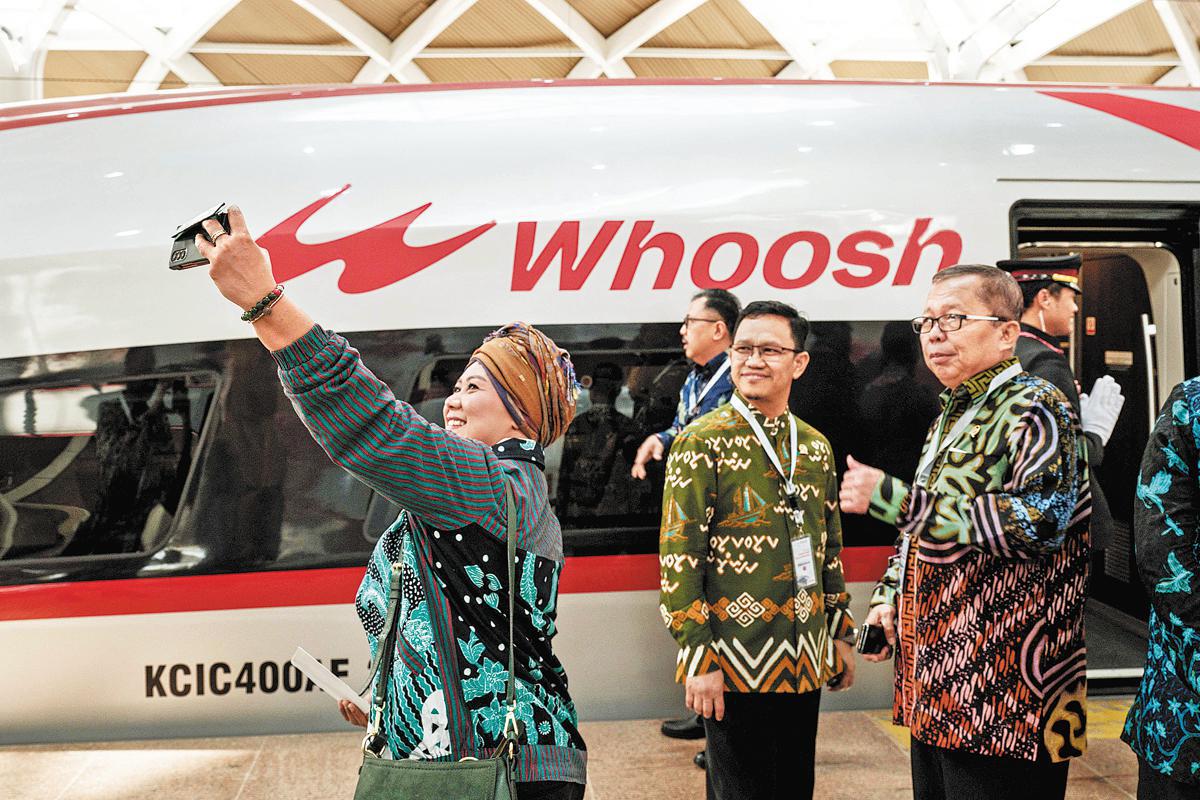
The impressive facts and figures in the encompassing policy document unveiled by China on Tuesday on the 10-year-old Belt and Road Initiative are a convincing illustration of the vast and tangible results achieved by the nation and its partners, and highlight the potential for the landmark vision's further growth, experts said.
They made these observations as the State Council Information Office held a news conference in Beijing to issue a white paper titled "The Belt and Road Initiative: A Key Pillar of the Global Community of Shared Future".
In September and October of 2013, President Xi Jinping proposed the initiatives of jointly building a Silk Road Economic Belt and a 21st Century Maritime Silk Road, which became known as the Belt and Road Initiative.
Over the past decade, the BRI has "helped to resolve global development challenges and improve the global governance system", and "has also opened up a new path for all humanity to realize modernization", the white paper said.
Noting that the BRI is "a public road open to all, not a private path owned by any single party", the document said the vision "is free from geopolitical calculations".
"Countries from Eurasia, Africa, the Americas, and Oceania are all welcome to participate in the initiative, regardless of their political system, historical background, culture, development stage, ideology, or religious beliefs, as long as they seek common development," it said.
Cong Liang, vice-chairman of the National Development and Reform Commission, noted that China's total imports and exports with countries involved in the BRI reached $19.1 trillion in the 2013-22 period, registering an average annual growth rate of 6.4 percent.
Speaking on the overall progress of the initiative, he noted that more than 150 countries and 30 international organizations have so far joined the BRI family.
Over the past decade, the countries' efforts to jointly build the Belt and Road "have fully realized the shift from a concept to actions, and from a vision to reality".
Guo Tingting, vice-minister of commerce, noted that two-way investment between China and other countries involved in the BRI totaled more than $380 billion between 2013 and 2022, among which China's outward direct investment exceeded $240 billion.
These countries "have also actively invested in China and shared China's development opportunities, with a cumulative total of more than $140 billion invested in China over the past decade and close to 67,000 new enterprises set up in China", she said.
Wang Yiwei, a professor at the School of International Studies and director of the Institute of International Affairs at Renmin University of China, said that over the past 10 years, "the BRI has found the key to spur economic growth, as it catalyzes infrastructure construction, the reshaping of production chains, and negotiations on investment and trade facilitation".
"Advancing poverty relief, narrowing wealth disparity and boosting effective global governance are the three major effects of the BRI's focus on infrastructure and connectivity," he said.
Highlighting fruitful outcomes achieved within the BRI framework, Xu Xiujun, director of the International Political Economy Department of the Chinese Academy of Social Sciences' Institute of World Economics and Politics, said the initiative "has listed producing tangible benefits for the peoples in countries taking part in the BRI as one of its major goals, and their sense of gain has indeed been constantly on the rise and increasingly self-evident".
He noted that as the vision has entered the stage of seeking high-quality development, it should work for more coordinated growth in connectivity among hardware and software.
Beijing is set to host the Third Belt and Road Forum for International Cooperation later this month, an event that will provide a venue for a wide range of highly anticipated bilateral and multilateral diplomacy.
Representatives from over 130 countries and more than 30 international organizations have confirmed their plans to attend the forum, Li Kexin, director-general of the Foreign Ministry's Department of International Economic Affairs, told reporters. China has so far held major gatherings on the BRI in 2017 and 2019.
The upcoming forum "is not only the grandest event to commemorate the 10th anniversary of the BRI, but also an important platform for discussing BRI cooperation", Li said, adding that the forum's detailed schedule will be released in due course.
China is ready to take the upcoming forum as an opportunity to make new achievements in high-quality co-building of the Belt and Road, he added.
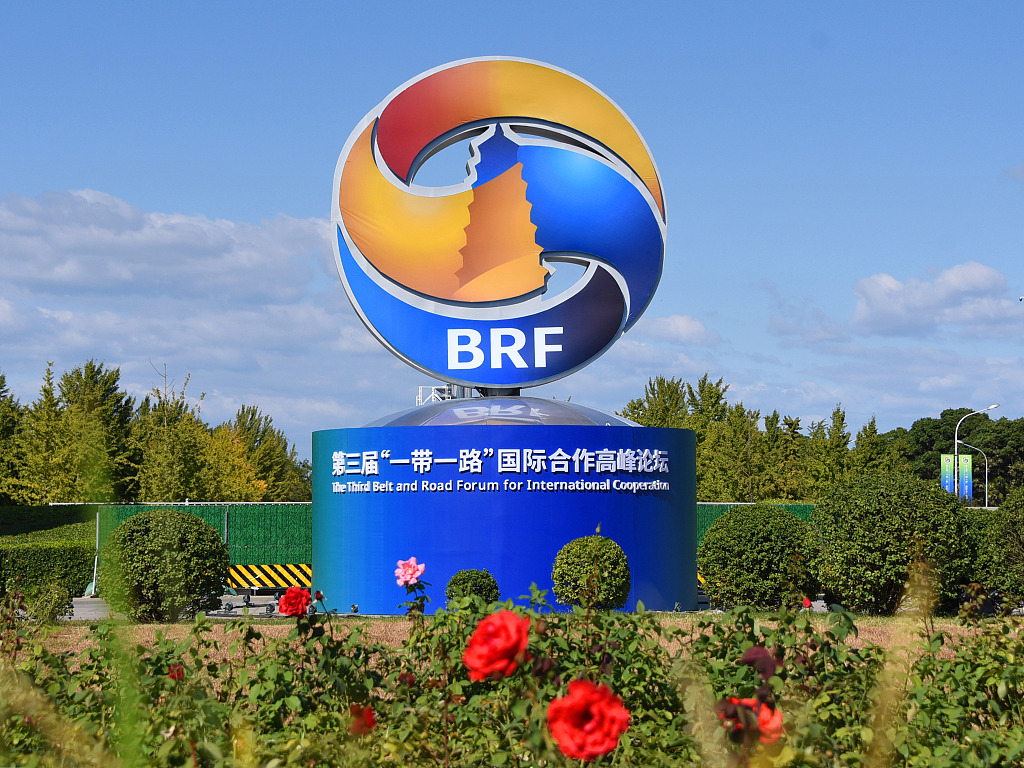
BEIJING - Participating countries will continue to facilitate trade, investment, and financial integration through the Belt and Road Initiative (BRI) cooperation, said a white paper released by China's State Council Information Office on Tuesday.
The white paper, titled "The Belt and Road Initiative: A Key Pillar of the Global Community of Shared Future," said that as its scope expands, the BRI has become the world's largest platform for international cooperation, with the broadest coverage.
Facilitating trade and investment is a major task in building the Belt and Road, said the white paper. The participating countries have worked hard to promote trade and investment liberalization and facilitation, remove investment and trade barriers, and improve the business environment within the region and in all related countries.
Efforts have been made to build free trade zones, broaden trading areas, improve trade structure, expand areas of mutual investment and industrial cooperation, establish a more balanced, equal and sustainable trading system, and develop mutually beneficial economic and trade relations, to make the "pie" of cooperation bigger.
Trade and investment are expanding steadily, according to the white paper. From 2013 to 2022, the cumulative value of imports and exports between China and other BRI countries reached $19.1 trillion, with an average annual growth rate of 6.4 percent. The cumulative two-way investment between China and other BRI countries reached $380 billion, including $240 billion from China.
By the end of August 2023, more than 80 countries and international organizations had subscribed to the Initiative on Promoting Unimpeded Trade Cooperation Along the Belt and Road, proposed by China. China had signed 21 free trade agreements with 28 countries and regions.
Financial integration is an important pillar of BRI cooperation, said the white paper. Participating countries and relevant institutions have carried out multiple forms of financial cooperation, created new models, expanded the channels, diversified the parties involved, and improved the mechanisms for investment and financing.
They have promoted policy-based finance, development finance, commercial finance, and cooperative finance to support BRI cooperation, and worked to build a long-term, stable and sustainable investment and financing system that keeps risk under control.
The financial cooperation mechanisms are maturing, said the white paper. China Development Bank (CDB) has promoted the establishment of multilateral financial cooperation mechanisms such as China-Central and Eastern Europe Interbank Consortium, the China-Arab Countries Interbank Association, China-ASEAN Interbank Association, the ASEAN Plus Three Interbank Cooperation mechanism, China-Africa Interbank Association, and the Association of China-LAC Development Financial Institutions.
The channels and platforms for investment and financing are constantly expanding, it said. China has funded the establishment of the Silk Road Fund (SRF) and established the Asian Infrastructure Investment Bank (AIIB) with other participating countries.
The SRF specifically serves BRI cooperation. By the end of June 2023, the fund had signed agreements on 75 projects with committed investment of about $22 billion; the number of AIIB members had reached 106, and the bank had approved 227 projects with a total investment of $43.6 billion.

The Belt and Road Initiative has built remarkably efficient railways connecting China and Europe via Central Asia. These rail routes did not exist even a decade ago. Within a short period, they have boosted local and national economies thanks to their solid infrastructure, smooth operation and socioeconomic impacts.
Between January and August in 2023 alone freight trains made 11,638 trips and transported 1.26 million twenty-foot equivalent units (TEUs) of cargo between Asia and Europe. The trains have an average speed of 120 kilometers an hour, and connect 86 routes that cover 217 cities in 25 European countries and more than 100 cities in 11 countries and regions in Asia.
Over the past 10 years, China-Europe freight trains have made a total of 77,000 trips, carrying 7.31 million TEUs of goods worth more than $340 billion.
At present, most cargo between China and Europe is transported along the so-called northern route that passes through Central Asia, Russia and Belarus. However, the shortest and most efficient southern route from Central Asia to China, and then through the South Caucasus to Europe, is gaining more attention. In this regard, the China-Kyrgyzstan-Uzbekistan section will be a promising inclusion to these routes.
In September 2022, an agreement was signed at the Shanghai Cooperation Organization Summit in Samarkand, Uzbekistan, to promote construction of a railway connecting China, Kyrgyzstan and Uzbekistan. Additional documents were signed during the China-Central Asia Summit in Xi'an, Shaanxi province, in May this year to conduct a feasibility study and work out a financing model.
The Kyrgyz section of the railway will start from the Torugart Pass, from where the railway line will extend northwest through Arpa and Makmal to Jalal-Abad, where it will connect with Uzbekistan's railway network. To facilitate that, the railway gauge will be changed from the standard gauge (1.43 meters) used in China and Europe to the standard gauge (1.52 m) found in Central Asia, probably in Makmal, which is home to a gold processing plant.
The Kyrgyz section of the railway will span 280 km, crossing rugged mountainous terrain and require the construction of at least 90 tunnels. The total cost of the project is estimated to be between $3 billion and $5 billion. Also, China will need to build about 160 km of access roads within its territory to connect to the new railway line.
After the completion of this section, the railway can be extended to the West, passing through Turkmenistan and Kazakhstan, the South Caucasian countries and Turkiye to ultimately reach Europe. This extension is expected to reduce the distance from China to Turkiye by about 900 km.
As for the return on the investment, the parties can recover their amount by collecting road toll, primarily for cargo being transported from China to Europe — estimated at 5 million tons of freight per year.
Central Asia is set to become a critical transport hub for the whole of Eurasia. The East-West transport corridor in this region will soon connect with the North-South corridor, linking the northern countries through Iran and Afghanistan with South Asian countries and the ports around the Indian Ocean. This will make Central Asia a vital transportation hub in the foreseeable future.
Some experts initially had doubts about the feasibility of building a railway in the challenging terrain of the Kyrgyz mountains. However, these doubts disappeared, considering the features of the newly built China-Laos railway. The China-Laos railway covers 1,035 km from Kunming in Southwest China's Yunnan province to the Laotian capital of Vientiane. The railway runs through high mountainous terrain with complex geology, high seismic risk and high geo-stress.
Moreover, the China-Laos railway crosses 218 faults and fractures as well as the Mekong River, with an altitude difference of 2,900 m. Despite these challenges, the railway has been built and newly features 301 bridges and 167 tunnels.
That China has paid special attention to the environment and the fragile ecology of the mountains during the construction of the railroad goes without saying. The railway bypasses multiple national nature reserve forests, including Xishuangbanna and Luang Prabang, as well as tourist attractions and national forest parks. The project was, therefore, designed to blend harmoniously with the environment along the route. The China-Laos railway has already started bearing economic fruit, especially for the tourist spots along the way.
Similarly, the railway connecting Asia and Europe through Central Asia will be a prime example of transportation infrastructure having a positive impact on the economy, promoting development in a region, and bringing different countries closer. With the latest transportation technologies, trade will be simplified and expedited, distances will be reduced, and people and cultures will come closer, leading to increased exchanges of knowledge and experiences.
The caravans of the ancient Silk Road facilitated intercultural and intellectual dialogue between people from different countries, shaping modern civilizations and promoting development.
In the same way, every train passing through Eurasia will bring economic prosperity through partnership and strengthen trust between peoples. The railway, when completed, has the potential of transforming Central Asia from a land-locked region to a land-connected hub for the whole of Eurasia. By channeling collective energy toward revitalizing new routes, the Belt and Road Initiative has been reviving the great spirit of the ancient Silk Road as a trade corridor and opening-up passages connecting people, cultures and civilizations.

The views don't necessarily reflect those of China Daily.
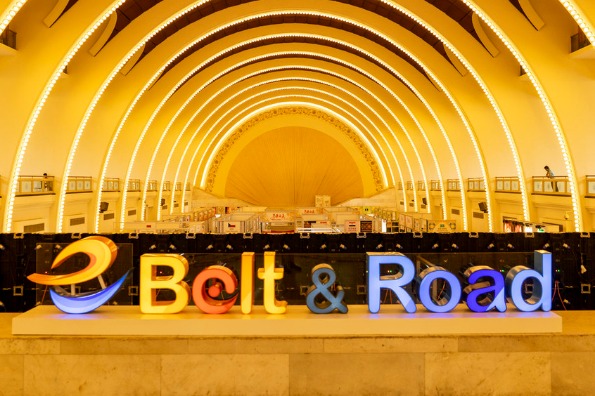
Investment in BRI economies grows 22.5% to 140b yuan in reporting period
China's outbound direct investment has continued to grow in the first eight months of this year, especially in economies involved in the Belt and Road Initiative, the Ministry of Commerce said on Thursday.
From January to August, China's outbound non-financial direct investment reached 585.61 billion yuan ($80.17 billion), up 18.8 percent year-on-year. In particular, Chinese companies' non-financial direct investment in the countries and regions involved in the BRI achieved 140.37 billion yuan, up 22.5 percent on a yearly basis, according to the Ministry of Commerce.
Meanwhile, during the eight months, turnover of China's foreign contracted projects reached 648.62 billion yuan, up 6.1 percent year-on-year. The value of China's newly signed contracts in foreign countries reached 863.34 billion yuan, a year-on-year increase of 2 percent.
The turnover of China's foreign contracted projects in the economies involved in the BRI reached 529.52 billion yuan, up 4.8 percent year-on-year. The value of China's newly signed contracts in BRI economies achieved 725.35 billion yuan, up 5.6 percent year-on-year, the ministry said.
Shenzhen CLOU Electronics Co Ltd, a subsidiary of Chinese home appliance maker Midea Group and a player in the global energy storage market, announced earlier this month that it established a company in the United States to strengthen its business in the North American market and further consolidate its industry position globally.
"Midea Group has strong confidence in the green energy sector. We will leverage our expertise in energy storage to dive deep into the green energy market. The establishment of the new company in the US will enable us to further penetrate the global market, including North America," said Fu Yongjun, vice-president of Shunde, Guangdong province-based Midea Group.
Additionally, the 10th China-European Union High-level Economic and Trade Dialogue will be held in Beijing on Monday and Chinese Vice-Premier He Lifeng will co-chair the meeting with European Commissioner for Trade Valdis Dombrovskis, said He Yadong, a spokesperson of the ministry during a news conference in Beijing on Thursday.
Speaking at a forum hosted by the Center for China and Globalization in Beijing on Thursday, Wu Hongbo, special representative of the Chinese government on European affairs, noted that both China and Europe have substantial untapped potential for cooperation.
"We have identified several promising areas for collaboration, including the green economy, digitalization, artificial intelligence and high-end manufacturing," Wu said.
"As the EU is a strong advocate of open economies and a staunch supporter of green development, fair and equitable international competition should act as a catalyst for its green development and transformation," he said.
Wu added that by replacing confrontation with cooperation, both China and the EU can enhance their ability to prevent and resolve risks while contributing to global economic development.
On another front, with the upcoming Mid-Autumn Festival and National Day holiday, a traditional peak period of consumption in China, the Ministry of Commerce is organizing a group of activities to help boost domestic spending.
The ministry will also help promote the introduction of a batch of policies and measures to support the aftermarket of cars to further push the accelerated consumption recovery in China.

Premier Li Qiang will attend and address the opening ceremony of the 20th China-ASEAN Expo and the China-ASEAN Business and Investment Summit in Nanning, in South China's Guangxi Zhuang autonomous region, on Sunday, Foreign Ministry spokeswoman Mao Ning said. The expo aims to promote trade and investment between China and ASEAN countries.
The event comes less than two weeks after Li attended the leaders' meetings on East Asia cooperation in Jakarta, the capital of Indonesia. At the meetings, the premier reached important understandings with leaders of ASEAN countries on deepening cooperation between China and ASEAN and building a "peaceful, safe and secure, prosperous, beautiful and amicable home" together, Mao said on Thursday.
The expo is an important platform for deepening bilateral cooperation and enhancing regional economic integration, Mao said. The theme of this year's expo is, "Work Together for a Harmonious Home and a Shared Future — Promoting High-Quality Development of the Belt and Road and Building an Epicentrum of Growth".
Through this year's expo, China hopes to work with all parties to seek opportunities, meet challenges and improve the implementation of the Regional Comprehensive Economic Partnership, Mao said.
The country also hopes to further liberalize and facilitate trade and investment between both sides, improve regional connectivity and jointly build an open regional economy.
Trade cooperation between China and ASEAN has developed steadily over the years. China has been ASEAN's largest trade partner for 14 consecutive years and both sides have remained each other's largest trade partner for three years in a row.
The accumulative two-way investment between China and ASEAN countries had exceeded $380 billion by July this year.
